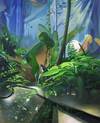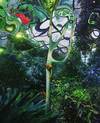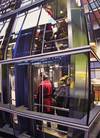Erik Nieminen Artist Statement
:: ABOVE BELOW ::
My works present an independent reality, a world that is dependent on our real world yet is separate from it. I seek to deconstruct the reality that we inhabit in order to remake reality according the logic inherent in the painting process. With that in mind my works cannot be identified as Realist, Photorealist, or Representational, just as they cannot be identified as Abstract, or Non-Objective. I am predominantly interested in the dissolution of space, perspective, light, and time through varying degrees of figuration and abstraction. Form is created through a responsive and adaptive process over a length of time, reworking the colours and shapes until an ideal solution is found. Thus the process itself mirrors the way time works – gradually shifting reality until what is familiar evolves into something renewed.
The paintings are fundamentally about perception. As soon as one takes a three-dimensional world and puts it on a two-dimensional surface it becomes metaphor. Linear perspective is an attempt to standardize the metaphor of the depiction of space – to make it stable for consumption – but it is not something that exists in nature just as two dimensions do not exist in nature. As part of nature we do not understand our surroundings through a hole as photography (in the conventional sense) does. Images in the 21st Century are interwoven with a restless uncertainty. Whereas in the past, we could look to mechanically produced images as a kind of document, it is no longer possible to do this with confidence. Subjectivity has been inserted into image making, to the extent that we are potentially in a post-photographic age. My work acknowledges the existence of mechanical imagery but also rejects it. It plays with the viewer’s assumptions regarding the verisimilitude of what we see and positions itself as post-photographic painting. It borrows from photographic vocabulary but its pictorial syntax is liberated from any preconditions.
My role in the creation of these works is actually relatively unimportant. I listen to the needs of the painting and the painting is in control. What I do therefore is to orchestrate possibilities, but to answer no question. Whereas mechanically conceived space settles itself directly in the heart of the mundane world, painting exists in a place in between realities, where time and conventional space are in a constant state of mutability. It is neither linear nor chronological. While the existence of a painting is a comment on our own world, it does not in and of itself have a determined meaning. It is open and exists for itself only, on its own terms. It asks unanswerable questions, the meanings of which are therefore only relevant to each individual viewer.
{{The genesis of these works can be found in observation, memory, drawing, and video documentation. A selection of early sketches is included as reference points for some of the finished works in the exhibition. These early sketches often start out as quite rough abstractions, and over time lines or shapes are replaced by objects or signals that function as kinds of avatars for their counterparts in our world.}}
__________________________________________________________________________________________________________________________________________________________________________
:: THE UNREAL ::
Reality. The term "reality" denotes what is real; in its widest sense, this includes everything that exists, whether or not it is observable or comprehensible. My paintings present an independent reality, a world that is dependent on our real world yet is separate from it. It is a world that exists on its own terms.
I am interested in what one could call 'ordinary fare'. I don't look for the exotic or the iconic. The scenes that I'm interested in are usually immediately familiar as social types and contemporary spaces. Within these unassuming locations, subjects, and situations, I try to tap into what I perceive as the endless narratives that happen around us all the time, without pushing any particular idea of defined storytelling onto the viewer.
I understand the city as a kind of construct, a fabrication that is intended to serve humanity in an organic, natural, and fluid manner. The city itself is a vast template for meaning, and it is inescapable that we absorb the meanings and intentions of the various images that we encounter throughout the urban fabric. However it is not these particular meanings that would generate a painting, as I do not intend for my paintings to have an outright describable interpretation or definition. The structure of the painting itself will create the meaning through the orchestration of an experience on the canvas. At their core, my works are architecturally more abstract than figurative, despite outward appearances. Consequently, I have frequently looked to early modernism – works by the cubists, the futurists, the constructivists, as well as contemporary abstract artists such as Kristin Baker, Tomma Abts, Albert Oehlen, among others as reference points. I work on individual pieces for extended periods of time, and what begins as non-objective eventually transforms into something that has been impregnated with identifiable elements from our world. The result is a pseudo-fabricated and sometimes surreal space that does not necessarily have a grounded connection to an actual place or time.
:: ABOVE BELOW ::
My works present an independent reality, a world that is dependent on our real world yet is separate from it. I seek to deconstruct the reality that we inhabit in order to remake reality according the logic inherent in the painting process. With that in mind my works cannot be identified as Realist, Photorealist, or Representational, just as they cannot be identified as Abstract, or Non-Objective. I am predominantly interested in the dissolution of space, perspective, light, and time through varying degrees of figuration and abstraction. Form is created through a responsive and adaptive process over a length of time, reworking the colours and shapes until an ideal solution is found. Thus the process itself mirrors the way time works – gradually shifting reality until what is familiar evolves into something renewed.
The paintings are fundamentally about perception. As soon as one takes a three-dimensional world and puts it on a two-dimensional surface it becomes metaphor. Linear perspective is an attempt to standardize the metaphor of the depiction of space – to make it stable for consumption – but it is not something that exists in nature just as two dimensions do not exist in nature. As part of nature we do not understand our surroundings through a hole as photography (in the conventional sense) does. Images in the 21st Century are interwoven with a restless uncertainty. Whereas in the past, we could look to mechanically produced images as a kind of document, it is no longer possible to do this with confidence. Subjectivity has been inserted into image making, to the extent that we are potentially in a post-photographic age. My work acknowledges the existence of mechanical imagery but also rejects it. It plays with the viewer’s assumptions regarding the verisimilitude of what we see and positions itself as post-photographic painting. It borrows from photographic vocabulary but its pictorial syntax is liberated from any preconditions.
My role in the creation of these works is actually relatively unimportant. I listen to the needs of the painting and the painting is in control. What I do therefore is to orchestrate possibilities, but to answer no question. Whereas mechanically conceived space settles itself directly in the heart of the mundane world, painting exists in a place in between realities, where time and conventional space are in a constant state of mutability. It is neither linear nor chronological. While the existence of a painting is a comment on our own world, it does not in and of itself have a determined meaning. It is open and exists for itself only, on its own terms. It asks unanswerable questions, the meanings of which are therefore only relevant to each individual viewer.
{{The genesis of these works can be found in observation, memory, drawing, and video documentation. A selection of early sketches is included as reference points for some of the finished works in the exhibition. These early sketches often start out as quite rough abstractions, and over time lines or shapes are replaced by objects or signals that function as kinds of avatars for their counterparts in our world.}}
__________________________________________________________________________________________________________________________________________________________________________
:: THE UNREAL ::
Reality. The term "reality" denotes what is real; in its widest sense, this includes everything that exists, whether or not it is observable or comprehensible. My paintings present an independent reality, a world that is dependent on our real world yet is separate from it. It is a world that exists on its own terms.
I am interested in what one could call 'ordinary fare'. I don't look for the exotic or the iconic. The scenes that I'm interested in are usually immediately familiar as social types and contemporary spaces. Within these unassuming locations, subjects, and situations, I try to tap into what I perceive as the endless narratives that happen around us all the time, without pushing any particular idea of defined storytelling onto the viewer.
I understand the city as a kind of construct, a fabrication that is intended to serve humanity in an organic, natural, and fluid manner. The city itself is a vast template for meaning, and it is inescapable that we absorb the meanings and intentions of the various images that we encounter throughout the urban fabric. However it is not these particular meanings that would generate a painting, as I do not intend for my paintings to have an outright describable interpretation or definition. The structure of the painting itself will create the meaning through the orchestration of an experience on the canvas. At their core, my works are architecturally more abstract than figurative, despite outward appearances. Consequently, I have frequently looked to early modernism – works by the cubists, the futurists, the constructivists, as well as contemporary abstract artists such as Kristin Baker, Tomma Abts, Albert Oehlen, among others as reference points. I work on individual pieces for extended periods of time, and what begins as non-objective eventually transforms into something that has been impregnated with identifiable elements from our world. The result is a pseudo-fabricated and sometimes surreal space that does not necessarily have a grounded connection to an actual place or time.
Erik Nieminen

















